(Three 28s)
The interpretation of Tally sticks is in a rudimentary stage of development for some examples, such as those being described as Paleolithic. Far too many interpreters are making wild and flamboyant interpretations which need to be addressed with a bit more rationality since they read like the accounts of those practicing some religious-level of revelation that all others should defer to. It is a rather curious feature to observe present day researchers automatically assume that a single piece of artefact is the work of a single individual. Whereas we have large monuments which took multiple people over many years to complete, we don't think to consider a small artefact the work of multiple people or even the same person working on something over a period of time, even though this is not an unusual activity. It is not common for us to encounter a researcher who suggests that a single artefact may be the work of several people.
For example, a person may pick up a stone use it for a period of time and then toss it aside, only to have it picked up by someone else who may or may not mimic the first person's activity in a monkey see- monkey do fashion of mimicry. Whereas it is easy for someone today to accept the view that a person working on a book with sustained and intermittent forms of cognitive energy over a period of time, we don't see this as a conventional perspective being offered by present day researchers when they come across an artefact such as a tally stick. It is common for us to consider that an artefact Automatically means it belonged to a single individual and was not part of a two-or more person group effort. Indeed, if a tally stick is thought of as a work of art or even genius by a given person, they may well be anxious to show it to someone who wants to add, subtract, exaggerate or even mark/cross out a given line or doodle because they are either thinking they can do better or make it better, or ruin its appearance. It is rather ridiculous to think that a tally stick is an expression of arithmetical behavior when it may be an instrument of artistic compilations.
If we take to heart Sir Francis Galton's reflection on the 3 traits of genius, one might assume that some ancient genius working on a tally stick would keep at it and not let anyone else either interrupt or subvert their efforts. (Galton, who inaugurated the systematic study of genius, formulated the theory that genius is a very extreme degree of these three combined traits:)
- Intellect
- Zeal
- Power of working
Living in an uncertain environment where hyper-vigilance was a necessity of survival and seen in animals whose attentiveness and sensitivity to sound, smells, vibrations and motions makes them appear to be paranoid schizophrenics, would undoubtedly played a role in the day to day life of primitive "brutes" that would have needed extended moments of feeling safe and secure in order to create a tally stick. If a modern person attempts to use the same medium of a bone or stick and an assumed sharp instrument as a claw or tooth, the intensity of attention needed to complete a task speaks to the context and person... unless they are much practiced at such a craft and might thus have made other such tally sticks. Unless of course one was so very special that they never parted with it. Let us itemize some questions:
- Were there periods of quiescence in which no immediate dangers were nearby?
- Was there forethought in the preparation for creating such an artefact?
- Did the task come after or before some other daily survival requirement?
- Were they "off by themselves" or being creative with one or more others nearby?
- Do individual lines always represent individual numbers?
- Do lines always represent numbers?
- Can some lines represent words (whatever verbal or gesture stood for a word or complete idea)?
- Can some lines represent a conjunction or punctuation?
- Were all tally sticks created for some utility and not as art?
- Did the sighting of a bone or stick typically arouse a sense of creating a tally stick?
- Were any tally sticks created as part of an assigned task by a superior or as a "show-off" gift?
- Were all tally sticks created by men (because women did most of the work and that is why they generally live longer)?
Surely those who strive to present a particular tally stick and its markings as an indication that early humans were more advanced in their mathematical thinking than we have heretofore given them credit for, won't mind if I throw a wrench into their assumptions with some very simple alternative suggestions. The idea that early humans were more complex thinkers than many have given them credit for means that such people may have had other-than mathematical ideas which were similarly suggestive as being more superior, unless we are to assume that some early humans were somehow geniuses in math but idiots at every other type of thinking. Were some early humans idiot savants that were noted as the village idiot but because there existed a well-developed social security system, they were nonetheless cared for an permitted not to have to otherwise contribute to the well-being of a village or clan or tribe? Were the leaders of primitive peoples so magnanimous that all injuries, illnesses and non-normal behavior were given over to some witch-doctor organization so that they could be cared for and studied?
Savant Syndrome:
Rare condition wherein a person of subnormal intelligence or severely limited emotional range has prodigious intellectual gifts in a specific area. Mathematical, musical, artistic, and mechanical abilities have been among the talents demonstrated by savants. Examples include performing rapid mental calculations of huge sums, playing lengthy compositions from memory after a single hearing, and repairing complex mechanisms without training. About 10% of autistic people are savants; mentally retarded people may also be savants, though the incidence is much lower. See also autism. ("savant syndrome." Encyclopædia Britannica, 2013.)
An example of a tally stick being viewed as representing some assumed individual with a gifted (ahead of their time?) mathematical prowess is the Ishango Bone: prime numbers (Mathematicians of the African Diaspora)
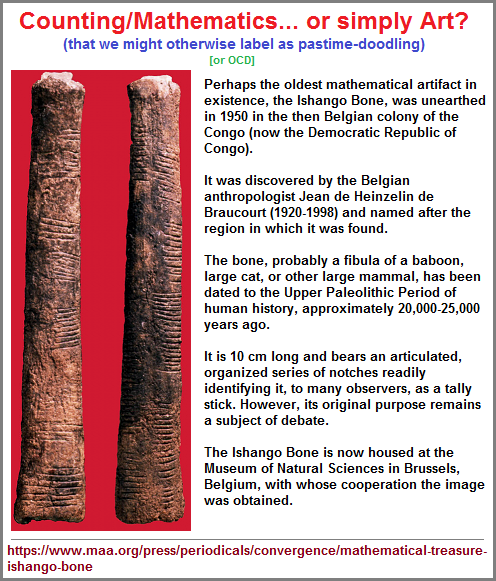
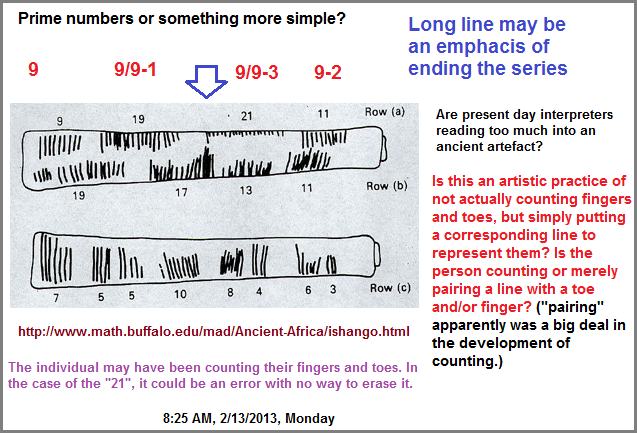
However, if such presumed mathematically advanced individuals were normal except for being able to think in a form of higher mathematics, and that all of humanity is to be astonished at such an ability (particularly if they are assumed to have been black, or poor, or sickly, or the handicapped LGBTQ oriented, or some other socially fringed minority); then please permit me to throw some cold water on you to stir you from your delusions of externally assigned grandeur. Let's you and I take a little trip into history by way of some easily understood and accepted ideology short-cuts of generality where there is no need to argue specific points about because they too have been incorporated as a given referencing suppositions.
Humanity had a history of rudimentary counting prior to the use of tally sticks. In other words, the use of tally sticks is an older tradition in the history of early human counting, and that different types of tallying were later used prior to any formalized book-keeping standard. Tally sticks can be viewed as a mathematical instrument as well as an account of perceived patterns, yet music, art and dance do this also, and may have preceded the use of tally sticks such as the creation of geometrically aligned triangular objects called arrow and spearheads, as well as knives and simple point or poking sticks. Whereas one might want to express the opinion that spear and arrow shafts if not also knives are artistically rendered representations of the male penis (called phallic symbols) since so much has been made of in religious studies involving Nature and fertility rites involving human births that early humans were ignorant of and in fact many people today remain so or there would be no need of sex education; the point is that the use of tally sticks is a later invention. Indeed, we even see the use of modern forms of tally sticks such as tape measures, belts with buckles and clasps which fit into different holes of waist measurement, and of course the piano keyboard is an example of an overlooked tally stick, as well as the common height measurement activity many children engage in, along with the use of fractions in describing their age. (For example, one child may say they are six years old and another claim they too are six, but the 1st child then says they are 6 and 1/2 and the other is 6 1/4 while a third claims themselves to be 6 and 3/4ths.)
However, since human fertility and in particular the regular cycle of blood during menstruation is something early humans were confronted with and needed to explain in a positive manner instead of a negative one, a correlation with some Natural occurrence was no doubt a revelation. In such terms, presence of 7 stars in the Big Dipper is not only fortuitous for the woman, but also because the value "7" had an impact on the overall history of chronology, in that we have 7 days of the week, 4 days to a month and 12 months to the year. Such numbers came to be regarded as both mystical and reverential. Let us look at a short excerpt on menstruation which gives us the (3- 4- 5) numbers used in the Pythagorean theorem, in that [3 x 7 = 21, 4 X 7 = 28, 5 X 7 = 35]:
The normal human menstrual cycle is 28 days, but no woman is always precisely regular, and cycles as short as 21 days or as long as 35 days are not abnormal. It is customary to call the first day of the menstrual period the first day of the cycle, although menstruation is the end rather than the beginning of a process. On this basis the cycle is described as starting with about five days of menstruation, followed by a proliferative phase that lasts to about the 14th day, and then a secretory phase that lasts until the next menstruation. The external manifestation of menstruation depends upon cyclical change in the lining of the body of the uterus. The lining, called endometrium, consists of tubular glands that open into the uterine cavity. The glands lie in a vascular framework, or stroma, and are separated by it. ("menstruation." Encyclopædia Britannica, 2013.)
One must wonder how difficult it might have been to develop a calendar if humanity did not have the "7" clues provided by the:
- 7 planets (wanderers) observations
- 7 Big Dipper (and Pleiades) star counts (occurring in different positions during the 4 events known as the 2 equinoxes and 2 solstices)
- 28 day menstruation divided by 4 gives us 7
It all seems a bit too coincidentally convenient; as if the night sky is a teacher's blackboard containing a hint that could be correlated with a more down-to-earth and personal reference such as that of menstruation. I wonder how difficult it would have been to develop a calendar if such "hints" didn't occur... (and I am not in anyway saying that some God did this.) Whereas I can see how the cycle of the Moon can have made a biological/physiological impression on humans and other creatures, but the presence of a 7-starred item in the night sky? Then again, how much of an influence did the Big Dipper play in the development of ideological orientations other than as the origination source for the Bid Dipper?
Needless to say, Tally sticks are still used in a variety of expressions such as the common grading system used in many schools. No less, the use of watches, thermometers, gas gauges in vehicles, the tally sticks called grocery receipts, etc... Thus to think that ancient humans used tally sticks only for rendering mathematical expressions or for mathematical purposes is too closed minded.
Let me adopt a system of generalized itemization to shorten the present expose' in order to get to the point:
- Humanity's efforts at learning to count had a sequential history which can be generalized into the 3-patterned expression of "1- 2- Many" (1 and many, 1- 2 and many, 1- 2- 3 and many, with different cultures using their own words, symbols as well as fits-and-starts, number-quantity revelation, episodic advances and retreats, etc...).
- The present day usage of the word "Infinity" is equivalent to the ancient use of the word "many, or heap, or plenty, or pile, or bunch," etc.." Many cultures exhibit the same use of 1 scribed line for the quantity "1", 2 scribed lines for the quantity "2", 3 scribed lines for the quantity "3"; but after this value there is a distinct change in how different people illustrate higher values.
- Some ancient peoples were more acutely aware of patterns occurring in Nature than other peoples.
- Discovered patterns might well have been considered a "special" knowledge and kept as a secret. Hence, it was the beginning of an "Occult" (hidden) and Pagan knowledge that may or may not have been attributed to 1 or many gods, or simply referred to in some larger cosmological sensibility.
We of today look upon stars as:
- Large groups called Constellations (of which there are 88).
- Smaller groups (parts of constellations) are called Asterisms.
- Individual stars have received names connoting some meteorological phenomena or symbolizing religious or mythological beliefs. ("constellation." Encyclopædia Britannica, 2013.)
Apparently, the idea that the Ancient Greeks created the constellations has been refuted because they have a parallel with the more ancient Euphratean culture as described in the deciphered Euphratean cuneiforms. ("constellation." Encyclopædia Britannica, 2013.)
Many observers through-out later ages (after pre-tally peoples) described groups of stars with names signifying a particular collection that we today know such as the Pleiades, Orion, etc., Constellations.

Many people claim that one or another tally stick references the cycles of the moon, which we of today claim to be 29+ days in length, but we might want to suggest that the imprecise observations of primitive peoples are to be given some latitude just as we would commonly render to a child or novice.

There exist at least three "28-count" tallies which ancient peoples could have crudely referenced (in a give or take, approximationist fashion).
- The cycle of the moon is roughly 28 days. (February typically has 28 days but every fourth year it has 29 days.)
- The Big Dipper's 7 stars counted at the 2 solstices and 2 equinoxes renders a 28 count (form which also came the Swastika symbol when illustrated artistically).
- The Big Dipper's seven stars can be individually counted and referenced with individual representations.
Note, the antiquity of the Swastika and its forgotten origin were subsequently taken up by later (though still ancient) cultures and referenced to some idea consistent with a given culture's prevailing ideology such as being viewed as a solar image with the extensions of the swastika seen as legs or arms. A look at a short reference concerning the Swastika may be of value for some readers:
Swastika: equilateral cross with arms bent at right angles, all in the same rotary direction, usually clockwise. The swastika as a symbol of prosperity and good fortune is widely distributed throughout the ancient and modern world. The word is derived from the Sanskrit svastika, meaning “conducive to well-being.” It was a favourite symbol on ancient Mesopotamian coinage. In Scandinavia the left-hand swastika was the sign for the god Thor's hammer. The swastika also appeared in early Christian and Byzantine art (where it became known as the gammadion cross, or crux gammata, because it could be constructed from four Greek gammas [Γ] attached to a common base), and it occurred in South and Central America (among the Maya) and in North America (principally among the Navajo).
In India the swastika continues to be the most widely used auspicious symbol of Hindus, Jainas, and Buddhists. Among the Jainas it is the emblem of their seventh Tirthankara (saint) and is also said to remind the worshiper by its four arms of the four possible places of rebirth—in the animal or plant world, in hell, on Earth, or in the spirit world.
The Hindus (and also Jainas) use the swastika to mark the opening pages of their account books, thresholds, doors, and offerings. A clear distinction is made between the right-hand swastika, which moves in a clockwise direction, and the left-hand swastika (more correctly called the sauvastika), which moves in a counterclockwise direction. The right-hand swastika is considered a solar symbol and imitates in the rotation of its arms the course taken daily by the Sun, which in the Northern Hemisphere appears to pass from east, then south, to west. The left-hand swastika more often stands for night, the terrifying goddess Ka-li-, and magical practices.
In the Buddhist tradition the swastika symbolizes the feet, or the footprints, of the Buddha. It is often placed at the beginning and end of inscriptions, and modern Tibetan Buddhists use it as a clothing decoration. With the spread of Buddhism, the swastika passed into the iconography of China and Japan, where it has been used to denote plurality, abundance, prosperity, and long life.
In Nazi Germany the swastika (German: Hakenkreuz), with its oblique arms turned clockwise, became the national symbol. In 1910 a poet and nationalist ideologist Guido von List had suggested the swastika as a symbol for all anti-Semitic organizations; and when the National Socialist Party was formed in 1919–20, it adopted it. On Sept. 15, 1935, the black swastika on a white circle with a red background became the national flag of Germany. This use of the swastika ended in World War II with the German surrender in May 1945, though the swastika is still favoured by neo-Nazi groups. ("swastika." Encyclopædia Britannica, 2013.)
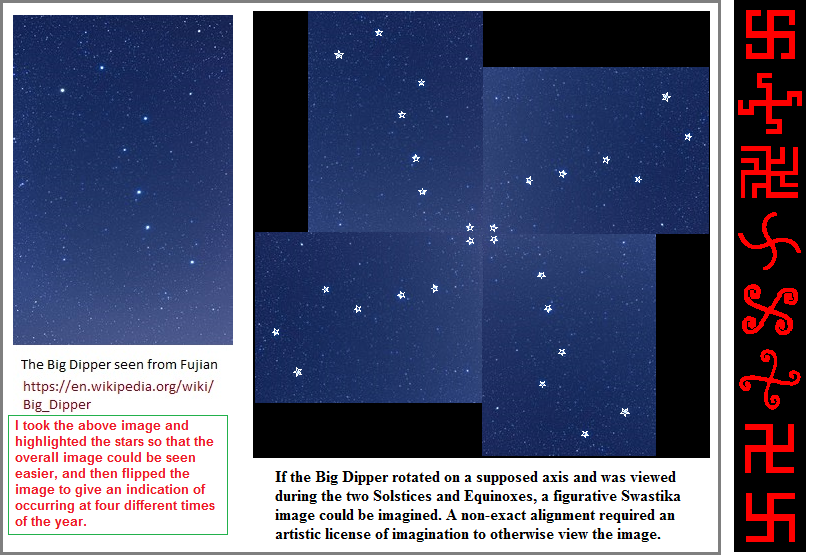

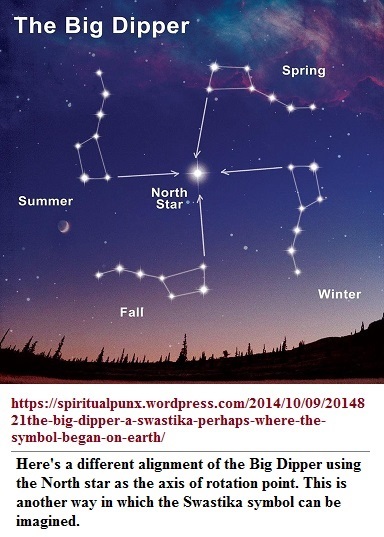
The grouping of seven stars that we of today call the Big Dipper was not necessarily the same label used by ancient peoples. In fact, they may not have grouped the stars as a singular collective but as a collective of singular stars, just as one person might say a particular group of people is the Johnson family while another refer to the group as Tom's or Mary's family, or even by naming the family individually. The way to view this is to imagine an early primitive scene of 7 star gazers (ancient Astronomers) making up an occult, secret society group. Each of the seven selected one of the seven stars and claimed the right to name it both similarly but distinctively. (Then again, the story of the blind men and the elephant could be used as a means of describing individual interpretations.
As such, the 1st member of the group took a claw, or sharp-edged stone, or animal talon (etc...) in hand and assigned a single mark to a bone or other medium... and may or may not have uttered some associated vocal sound or gesture denoting ownership. Each of the 7 members did the same. Whereas you might think they would simply add another single line, they instead expressed a distinction by adding a line to the line(s) which was/were already present, in order to express an individual distinctiveness.
Hence, we encounter a 1-line mark next to which a 2-lines mark appeared, and then in succession they scored a 3-lines mark, 4-lines mark, 5-lines mark, 6-lines mark, 7-lines mark; which totals up to be 28 lines. It was like having 7 distinct signatures being added to a tally bone or stick, or whatever medium was used.

Like those signing a Declaration of Independence or any other document thought to be significant. The separate counts of lines were like individual names place next to one another, with some "names" being emphasized just like John Hancock did on the American Declaration of Independence, and many people adopt some particular fashion in the writing of their name to describe an assumed distinctiveness. There are expressed lines of distinction on tally sticks/bones. A group of lines need not necessarily represent a count of something with a particular quantity, but as an account of a singular distinction like someone using four lines to say the word "ball" and five lines to say "balls".
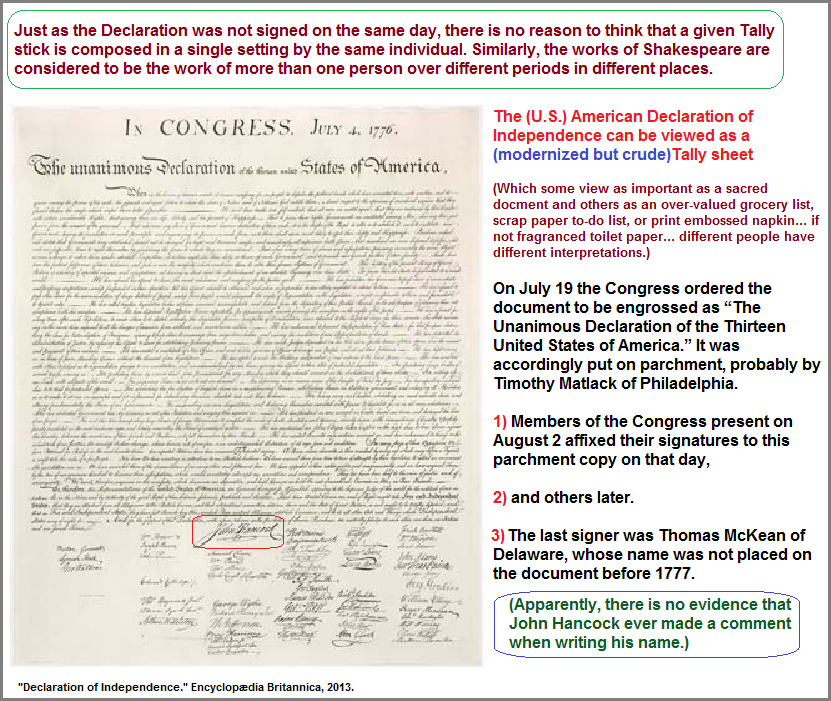
Note the arrangement of signatures. Some close, others separated, and most to the right side of the paper/parchment. Were there any "John Hancock"-like signatories in the ancient (Paleolithic) past?
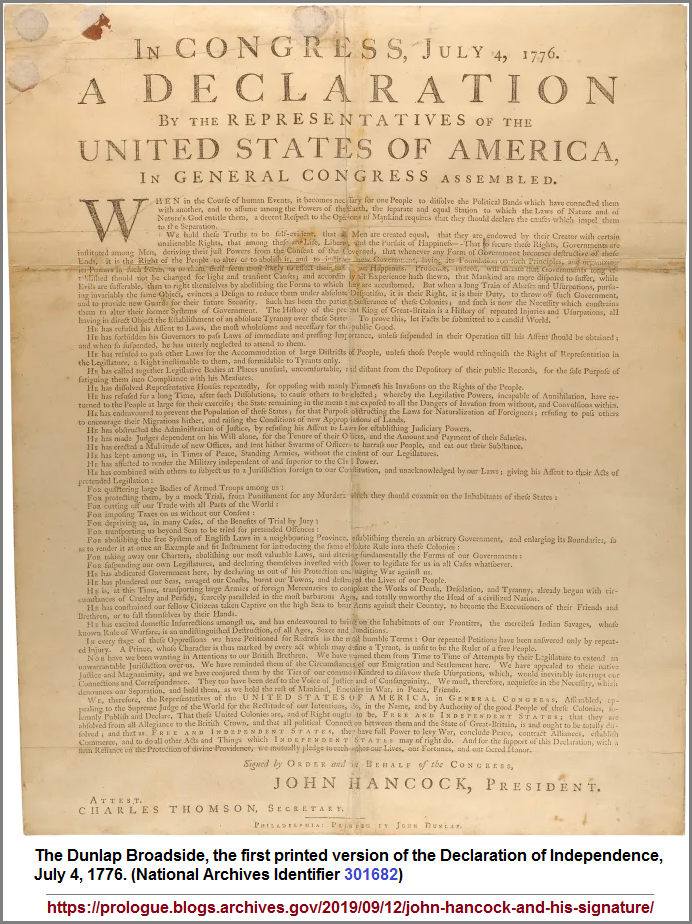
Tally Stick/Bone Researchers as of March 5th, 2023
One group of lines, just like single lines, can reference singularity, multiplicity, or an exact count. A grouping of lines does not have to mean a particular quantity, it could present a quality or a quality and a quantity like someone adding a prefix or suffix. If we assume a primitive person engaged only in the use of single-digit referencing, than single lines and single groups of lines could be an accurate count. However, if a "writer" of a tally stick had a more expressive vocabulary (cognitive associative ability), then they may have been using lines and groups of lines to express multiplicity, singularity, geometry, etc... Whereas we of today count individual tally marks as one might count the individual letters of an alphabet, what if a single line or groups of lines represent a word, or sentence, or paragraph, or a story, or rudimentary equation, or doodling?
How does a person express a complex thought or dream on a piece of bone with an animal claw if they have no other vocabulary than that of a short, medium, and long line repertoire? Similarly, how does an artist express themselves if they have only three colors to work with and the medium is the size and hardness of an animal thigh bone? How does a doctor explain to a patient their condition if the patient is ignorant or the doctor speaks in the vernacular of a medical textbook? How does a mechanic fix a carburetor if they have only a big stone to work with? How many people actually understand the story of a cook with three stones to make broth with?
Date of Origination: Sunday, 5th March, (approx.) 5:30 AMInitial Posting date: Sunday, 5th March... 3:00 PM